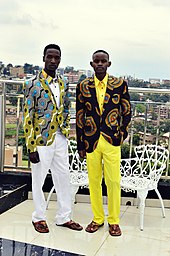La Sape

La Sape, an abbreviation based on the phrase Société des Ambianceurs et des Personnes Élégantes (French; literally "Society of Ambiance-Makers and Elegant People") and hinting to the French slang word sape which means "clothes" or sapé, which means "dressed up", is a subculture centered on the cities of Kinshasa and Brazzaville in the Democratic Republic of the Congo and Republic of Congo respectively. An adherent of La Sape is known as a sapeur or, if female, as a sapeuse.[1][2] The movement embodies the elegance in style and manners of colonial predecessor dandies.[3]
History
La sape can be traced back to the period of colonialism in Africa,[3] particularly in the cities of Brazzaville and Kinshasa.

The houseboys used their connections in France to acquire their clothing.
According to Gondola, Camille Diata frontlined the sape movement in Brazzaville in the 1930s, but also had a deep influence in France. He was also part of L'Amicale, "a loosely organized anti-colonial movement," formed in France in 1926 by the imaginative Congolese revolutionary André Matsoua. The organization mainly helped Africans new to Paris get settled in the city because they were not welcomed well by the French, facing imprisonment and deportation. By the time of Matsoua's death in 1942, his political developments gained prominence in the Congo and were "hijacked" by the Congolese intellectual elite. They not only adapted the fashion sense but also his anti-colonial views. This movement became a distinctly ethnic Bakongo and Balari one characterized by potent political symbolism and ideology that would manifest in postcolonial era.

The 1950s gave rise to the cosmopolitan, thus bringing prominence to the music scene. Nightclubs and beer halls made up the venues home to the music and young urbanites of the Congolese townships of Kinshasa and Brazzaville. During the postcolonial years, the unique dynamics of La Sape coalesced in 1960 when both Congos were granted independence. Economic chaos ensued and many were left jobless. This caused numerous Congolese people to move abroad to western cities like London and Paris. Since they were also not very welcome, La Sape acted as refuge for them to cope with European life.
Papa Wemba, a Congolese musician, is credited with reviving la sape in Kinshasa during the 1970s by emphasizing the importance of smartly dressed Congolese men.[3]
See also
- Swenkas – a similar movement in South Africa
- Stilyagi – a similar movement in Soviet Russia
- Zoot Suit
- 1980s in African fashion
- 2010s in African fashion
References
- ^ Evancie, Angela (7 May 2013). "The Surprising Sartorial Culture Of Congolese 'Sapeurs'". National Public Radio. Retrieved 17 January 2014.
- ^ Kembrey, Melanie (3 May 2019). "Strutting with La Sape: Tariq Zaidi captures the extraordinary". The Sydney Morning Herald. Retrieved 24 November 2019.
- ^ a b c Lyons, Juliette (12 May 2014). "La Sape : an elegance that brought peace in the midst of Congolese chaos". Le Journal International. Retrieved 24 November 2019.
Further reading
- Gondola, Ch. Didier (1999). "Dream and Drama: The Search for Elegance among Congolese Youth". African Studies Review. 42 (1): 23–48. doi:10.2307/525527. JSTOR 525527. S2CID 145371289.
- Gondola, Didier (2019), “Le moi, le moine et le moineau : Métamorphoses de l’imaginaire de la sape à Kinshasa” [“Ego, Identity, Illusion. Metamorphoses of a Fantasy : La Sape in Kinshasa”] BILINGUAL EDITION, pp. 186-207, in Dominique Malaquais, editor, Kinshasa Chroniques/Kinshasa Chronicles, Montreuil (France): Les Éditions de l’œil.
- Friedman, Jonathan (1990), “The Political Economy of Elegance. An African Cult of Beauty,” Culture and History VII: pp. 101-125.
- Gandoulou, Justin-Daniel (1984), Entre Bacongo et Paris. Paris: centre Georges Pompidou.
- Gandoulou, Justin-Daniel (1989), Dandies à Bacongo. Le culte de l’élégance dans la société congolaise contemporaine. Paris: L’Harmattan.
- Thomas, Dominic (2003), "Fashion Matters: 'La Sape' and Vestimentary Codes in Transnational Contexts and Urban Diasporas," MLN , Sep., 2003, Vol. 118, No. 4, French Issue (Sep.), pp. 947-973.
External links
- Dimanche à Brazzaville (Sunday in Brazzaville) documentary website
- Dimanche à Brazzaville on Vimeo
- The Sapeurs of Kinshasa on BBC World Service
- The Congolese Sape photo essay by Héctor Mediavilla
- Congo's dandies give new meaning to fashion victim from Agence France-Presse
- Congolese dandies: Meet the stylish men and women of Brazzaville – in pictures – The Guardian
